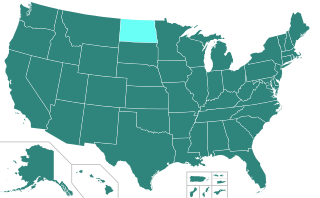
A popular initiative is a form of direct democracy by which a petition meeting certain hurdles can force a legal procedure on a proposition. The hurdles the petition has to meet vary between countries, typically signatures by a certain number of registered voters.

Voting rights, specifically enfranchisement and disenfranchisement of different groups, has been a moral and political issue throughout United States history.

In California, a ballot proposition is a referendum or an initiative measure that is submitted to the electorate for a direct decision or direct vote. If passed, it can alter one or more of the articles of the Constitution of California, one or more of the 29 California Codes, or another law in the California Statutes by clarifying current or adding statute(s) or removing current statute(s).
In the politics of the United States, the process of initiatives and referendums allow citizens of many U.S. states to place legislation on the ballot for a referendum or popular vote, either enacting new legislation, or voting down existing legislation. Citizens, or an organization, might start an initiative to gather a predetermined number of signatures to qualify the measure for the ballot. The measure is placed on the ballot for the referendum, or actual vote.

In the politics of the United States, elections are held for government officials at the federal, state, and local levels. At the federal level, the nation's head of state, the president, is elected indirectly by the people of each state, through an Electoral College. Today, these electors almost always vote with the popular vote of their state. All members of the federal legislature, the Congress, are directly elected by the people of each state. There are many elected offices at state level, each state having at least an elective governor and legislature. There are also elected offices at the local level, in counties, cities, towns, townships, boroughs, and villages; as well as for special districts and school districts which may transcend county and municipal boundaries.

Proposition 200, the "Arizona Taxpayer and Citizen Protection Act", was an Arizona state initiative passed in 2004 that basically requires: (a) persons to provide proof of citizenship to register to vote; (b) voters to present a photo identification before receiving a ballot at the polling place; and (c) state and local agencies to verify the identity and eligibility, based on immigration status, of applicants for non-federally mandated public benefits. The proposition also makes it a misdemeanor for public officials to fail to report violations of U.S. immigration law by applicants for those public benefits and permits private lawsuits by any resident to enforce its provisions related to public benefits. The requirement to provide proof of citizenship to register to vote was later ruled invalid in federal court.

Voter registration in the United States is required for voting in federal, state and local elections. The only exception is North Dakota, although cities in North Dakota may register voters for city elections. Voter registration takes place at the county level in many states and at the municipal level in several states. Most states set cutoff dates for voter registration and to update details, ranging from 2 to 4 weeks before an election; while a third of states have Election Day or "same-day" voter registration which enables eligible citizens to register or update their registration when they vote before or on election day.

The District of Columbia holds general elections every two years to fill various D.C. government offices, including mayor, attorney general, members of the D.C. Council, members of the D.C. State Board of Education, and members of its Advisory Neighborhood Commissions. Special elections may be held to fill vacancies at other points in time. Additionally, citywide ballot measures may be proposed and voted on.
The right of non-citizens to vote in the United States has historically been a contentious issue. Since 1997, the Illegal Immigration Reform and Immigrant Responsibility Act of 1996 has prohibited non-citizens from voting in federal elections, with the threat of fines, imprisonment, inadmissibility and deportation. Exempt from punishment is any noncitizen who, at the time of voting, had two natural or adoptive U.S. citizen parents, who began permanently living in the United States before turning 16 years old, and who reasonably believed that they were a citizen of the United States. At one point or another before 1926 40 states had non-citizens voting in elections. While federal law does not prohibit noncitizens from voting in state or local elections, no state has allowed noncitizens to vote in statewide elections since Arkansas became the last state to outlaw noncitizen voting in state elections in 1926. As of December 2022, at least thirteen local jurisdictions allow non-citizen voting, namely Winooski and Montpelier in Vermont, and eleven in Maryland near Washington, D.C. In 2023, D.C. itself started allowing local non-citizen voting. Additionally, the U.S. territories of American Samoa and the Northern Mariana Islands allow non-citizen US nationals to vote, a status granted to all persons born in American Samoa. All persons born in the Northern Mariana Islands automatically become US citizens at birth, as opposed to becoming US nationals at birth. Guam and Hawaiʻi, by contrast do not allow non-citizen US nationals to vote.

Elections in Oregon are all held using a Vote by Mail (VBM) system. This means that all registered voters receive their ballots via postal delivery and can vote from their homes. A state Voters’ Pamphlet is mailed to every household in Oregon about three weeks before each statewide election. It includes information about each measure and candidate in the upcoming election.

Jocelyn Benson is an American academic administrator, attorney, and politician serving as the 43rd Secretary of State of Michigan since 2019. A member of the Democratic Party, she is a former dean of Wayne State University Law School, a co-founder of the Military Spouses of Michigan, and a board member of the Ross Initiative in Sports for Equality. Benson is the author of State Secretaries of State: Guardians of the Democratic Process.
Buckley v. American Constitutional Law Foundation, Inc., 525 U.S. 182 (1999), was a United States Supreme Court case that dealt with the authority of states to regulate the electoral process, and the point at which state regulations of the electoral process violate the First Amendment freedoms.

Frank LaRose is an American politician. He was elected Secretary of State of Ohio in 2019. He was a Republican member of the Ohio State Senate for two terms, from January 2011 to January 2019. He was a Republican candidate for the U.S. Senate in the 2024 election, challenging incumbent Senator Sherrod Brown. He lost to Bernie Moreno in the primary.
Voter suppression in the United States consists of various legal and illegal efforts to prevent eligible citizens from exercising their right to vote. Such voter suppression efforts vary by state, local government, precinct, and election. Voter suppression has historically been used for racial, economic, gender, age and disability discrimination. After the American Civil War, all African-American men were granted voting rights, but poll taxes or language tests were used to limit and suppress the ability to register or cast a ballot. The Civil Rights Act of 1964 improved voting access significantly. Since the beginning of voter suppression efforts, proponents of these laws have cited concerns over electoral integrity as a justification for various restrictions and requirements, while opponents argue that these constitute bad faith given the lack of voter fraud evidence in the United States.

The 2021 New York state elections were held on November 2, 2021. In addition to the standard local elections, many seats for the New York Supreme Court were to be filled in addition to ballot proposals regarding changing state electoral rules and court limits.

2022 Michigan Proposal 3, the Right to Reproductive Freedom Initiative, also known as Reproductive Freedom for All, was a citizen-initiated proposed constitutional amendment in the state of Michigan, which was voted on as part of the 2022 Michigan elections. The amendment, which passed, codified reproductive rights, including access to abortion, in the Constitution of Michigan.
The following is a list of ballot measures which were on the ballot for the 2022 United States elections. Some were held prior to the federal elections on November 8. Many were initiated by state legislatures, while others were initiated by public petitions.

A special election was held in the U.S. state of Ohio on August 8, 2023, on a referendum to make it substantially harder for voter-led initiatives to amend the Ohio State Constitution to be proposed and approved.
The following is a list of ballot measures, whether initiated by legislators or citizens, which have been certified to appear on various states' ballots during the 2024 United States elections as of 17 December 2023.















